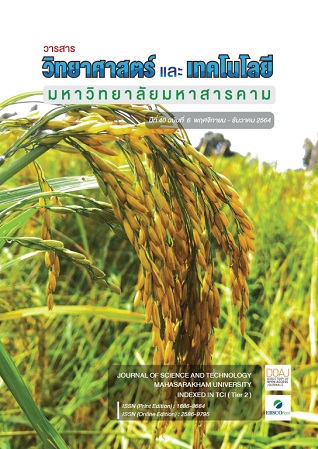BirthSim: A Shoulder Dystocia Simulator
Main Article Content
Abstract
Shoulder dystocia is is an emergency during labor that requires a good understanding of its internal mechanisms. But today's media cannot present inside the body during childbirth. This article therefore presents the process of developing a simulated Shoulder dystocia media called BirthSim. using virtual reality technology. The results showed that The satisfaction of 35 nursing students was at a high level. by content They were satisfied with the media that presented the content consistent with the course content, Perceived benefits Satisfaction with media stimulates learning and media to enhance decision-making skills and problem solving, In terms of media opinions, they were satisfied with the media being modern. and novel, different from the usual learning the most and the component aspect of the media was the most satisfied with the composition of the art composition. It shows that BirthSim can be applied in the study of nursing students. for students to practice skills Revisiting the right principles to gain confidence and able to apply knowledge and skills to practice in real practice.
Article Details
References
ณัฏจิรา วินิจฉัย , กชกร เพียซ้าย และพรสิงห์ นิลผาย . (2564). ผลของการจัดการเรียนรู้ด้วยโปรแกรม Simulation ฉีดยา ต่อความพึงพอใจของนักศึกษาพยาบาลศาสตร์ชั้นปี ที่ 2 . วารสารการพยาบาลและสุขภาพ , 15(1) , 1-11.
จัณทร์ปภัสร์ เครือแก้ว และคณะ. (2558). รูปแบบการจัดการเรียนการสอนรายวิชาผดุงครรภ์สำหรับนักศึกษาพยาบาล เพื่อเตรียมสอบ ขึ้นทะเบียนเป็นผู้ประกอบวิชาชีพการพยาบาลและการผดุงครรภ์ . วารสารมหาวิทยาลัยนราธิวาสราชนครินทร์ , 10(1) , 13-26 .
ชญาภรณ์ เอกธรรมสุทธิ์ และเกสร สุวิทยะศิริ . (2560). การสร้างความรู้ผ่านทักษะการแก้ปัญหา. วารสารวิทยาลัยบรมราชชนนี กรุงเทพ. 33(1). 177-183.
เอกรัฐ หล่อพิเชียร . (2560). การใช้สื่อการเรียนรู้ความเป็นจริงเสริม (Augmented Reality) เรื่อง โปรโตคอล TCP/IP เพื่อเพิ่มผลสัมฤทธิ์ทางการเรียนของนักศึกษาวิชาการสื่อสารข้อมูล และเครือข่ายคอมพิวเตอร์ สาขาเทคโนโลยีสารสนเทศการศึกษาคณะครุศาสตร์อุตสาหกรรม มหาวิทยาลัยเทคโนโลยีราชมงคลธัญบุรี . การประชุมวิชาการมหาวิทยาลัยเทคโนโลยีราชมงคล ครั้งที่ 9 "ราชมงคลสร้างสรรค์นวัตกรรมที่ยั่งยืนสู่ประเทศไทย 4.0" (Creative RMUT and Sustainable Innovation for Thailand 4.0).
ภัทรวิท สรรพคุณ , พีรยศ ภมรศิลปะธรรม และลาวัลย์ ศรัทธาพุทธ. (2557). เกมการศึกษาด้านการแพทย์และสุขภาพ . ไทยเภสัชศาสตร์และวิทยาการสุขภาพ , 9(2) . 82-87 .
ภัทราวดี วงศ์สุเมธ . (2556). ปัจจัยที่มีอิทธิพลต่อการยอมรับ และการใช้งานระบบการเรียนผ่านเว็บ .วารสารนักบริหาร , 33(3) . 3-10.
สิริมา ภิญโญอนันตพงษ์. (2547). การวัดและประเมินแนวใหม่ : เด็กปฐมวัย.กรุงเทพฯ: ภาควิชาหลักสูตร และการสอน สาขาการศึกษาปฐมวัย คณะศึกษาศาสตร์ มหาวิทยาลัยศรีนครินทรวิโรฒ.
Todd P. Chang, & Debra Weiner. (2016). Screen-Based Simulation and Virtual Reality for Pediatric Emergency Medicine. Clinical Pediatric Emergency Medicine, 17(3). 224-230.
Ann L. Butt, Suzan Kardong-Edgren & Anthony Ellertson. (2018). Using Game-Based Virtual Reality with Haptics for Skill Acquisition. Clinical Simulation in Nursing, 16. 25-32.
Margaret Verkuyl, Daria Romaniuk, Lynda Atack & Paula Mastrilli. (2017). Virtual Gaming Simulation for Nursing Education an Experiment. Clinical Simulation in Nursing, 13. 238-244.
Sabha Ganai, Joseph A. Donroe, Myron R. St. Louis, Giavonni M. Lewis & Neal E. Seymour. (2007). Virtual-reality training improves angled telescope skills in novice laparoscopists. The American Journal of Surgery, 193(2). 260-265.
Sharon L Farra, Sherrill J Smith & Deborah L Ulrich. (2018). The Student Experience with Varying Immersion Levels of Virtual Reality Simulation. Nursing Education Perspectives, 39(2). 99-101.
Sherrill J Smith, Sharon L Farra, Deborah L Ulrich, Eric Hodgson, Stephanie Nicely & Angelia Mickle. (2018). Effectiveness of Two Varying Levels of Virtual Reality Simulation. Nursing Education Perspectives, 39(6). 10-15.
Sherrill J Smith, Sharon Farra, Deborah L Ulrich, Eric Hodgson, Stephanie Nicely & William Matcham. (2016). Learning and Retention Using Virtual Reality in a Decontamination Simulation. Nursing Education Perspectives, 37(4). 210-214.
Jessica Williams, Donovan Jones & Rohan Walker. (2018). Consideration of using virtual reality for teaching neonatal resuscitation to midwifery students. Nurse Education in Practice, 31. 126-129.
Dale C Alverson, Stanley M Saiki Jr, Summers Kalishman, Marlene Lindberg, Stewart Mennin, Jan Mines, Lisa Serna, Kenneth Summers, Joshua Jacobs, Scott Lozanoff, Beth Lozanoff, Linda Saland, Steven Mitchell, Berthold Umland, Gordon Greene, Holly S Buchanan, Marcus Keep, David Wilks, Diane S Wax, Robert Coulter, Timothy E Goldsmith & Thomas P Caudell. (2008). Medical students learn over distance using virtual reality simulation. Simulation in Healthcare: The Journal of the Society for Simulation in Healthcare. 3(1). 10-15.
Shi Chen, Jiawei Zhu, Cheng Cheng, Zhouxian Pan, Lingshan Liu, Jianhua Du, Xinhua Shen, Zhen Shen, Huijuan Zhu, Jihai Liu, Hua Yang, Chao Ma, Hui Pan (2020). Can virtual reality improve traditional anatomy education programmes? A mixed-methods study on the use of a 3D skull model. BMC Med Educ. 2020 Oct 31;20(1):395.
Helen Berg, Aslak Steinsbekk. Is individual practice in an immersive and interactive virtual reality application non-inferior to practicing with traditional equipment in learning systematic clinical observation? A randomized controlled trial. BMC Med Educ. 2020 Apr 22;20(1):123.


